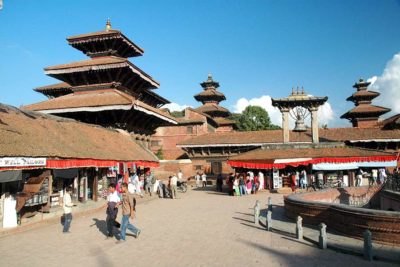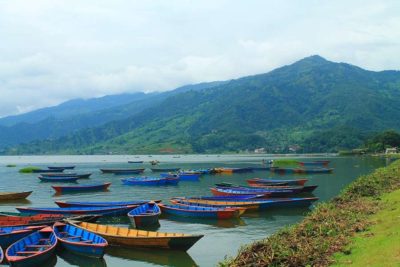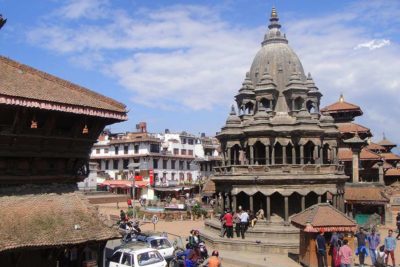India and Nepal
14 days
This special itinerary was designed to offer the main tourist attractions and the best responsible tourism projects of Northern India, and Nepal, all enclosed in a single tour. This itinerary will overwhelm you with all the Indian wonders: the grand and fascinating architectures, the deep religious sense, the human and cultural variety. The journey will begin in Delhi, the capital of India: here you will have the chance to visit the heart of the old city, the ancient district of Paharganj, with an exceptional tourist guide from a local NGO that helps street kids, taking care of their education, job training and access to health services. Next stop will be Nawalgarh, a small and less known town, with refined Havelis, and a colorful and lively bazaar. Here you will stay in an eco-lodge involved in several activities, which support development projects for the local community. Then you will visit Jaipur, as knonw as the pink city, the largest city in Rajasthan, and the city of Agra with the famous Taj Mahal. Last stop in Northern India, before your transfer to Nepal, is Delhi, from which you can leave India with an international flight and reach Kathmandu. Once in Nepal, in the next 8-days, you will explore and discover the main cities and attractions of this wonderful country, experience the culture, nature and the deep sense of spirituality of Nepal. This tour includes four of the major cities in Nepal: Kathmandu, the cultural, economic and historical hearth of this land; Pokhara, known as ”City of Lakes” and “The jewel of Himalaya” for its breathtaking beauty and natural landskapes; Chitwan, well known for its national park and its rich flora and fauna; Nagarkot which offers great views of Himalayas, attractive mountain scenery and impressive views of those mountains at sunrise and sunset. All the four cities are situated at different altitudes ranging from 60 meters to 2100 meters above sea level and with uniquely different characteristics like difference in temperature, landscapes, biodiversity and phenomenal views of the majestic mountain ranges. From peaceful villages to the wild jungles where the one-horned rhino and the elusive Royal Bengal tiger roam. You may choose from various adventurous activities such as White-water Rafting, Paragliding, Ultra-light air gliding, Canyoning, Mountain Biking, Cable Car ride, Zip Flyer, Mountain (Everest) Flight, Bungee Jump, Hiking, and much more. Before returning to Kathmandu for your international flight, you can enjoy many nature activities in the jungle at Chitwan National Park, including: bird watching, boating, jeep safari and, of course, forest walks which will allow you to admire the immense local biodiversity.
SIGN UP FOR THE TRIP
Registration can be requested for group travel or for self-travel. For group travel, registration is not binding. Upon reaching the minimum number of members necessary for the formation of the group, usually 4 or 6 people, you will be asked for confirmation of booking and payment of a deposit.
JOURNEY OVERVIEW AND PROGRAM DETAILS
1° DAY: ARRIVAL IN DELHI
Delhi
Arrival at Delhi airport. Transfer to hotel for some rest. Around 10 am after breakfast you will start your guided tour of Old Delhi. In particular, you will visit the Red Fort (visit only from outside), a UNESCO World Heritage since 2007, built in 1639 by Mughal Emperor Shah Jahan (the creator of the Taj Mahal), the the Jama Masjid, one of the largest mosques in India, where an ancient copy of the holy Quran written on Deer skin is preserved. Visit small lanes of this part of the city such as Chawri Bazar, one of the busiest street of Old Delhi. Later visit Raj Ghat, the site of Mahatma Ghandi cremation. After lunch you will visit new Delhi with its Government buildings such as the India Gate, an arch erected in memory of the Indian soldiers who lost their lives fighting for the British Army during World War I, and the Parliament House. In the late afternoon we will continue the visit with the Gurudwara Bangla Sahib, one of the most prominent Sikh gurdwara, or Sikh house of worship in India, known as the “Sarovar.” Then trasfer to the hotel.
Overnight in Delhi. (D)
2° DAY: TRANSFER TO NAWALGARH
Delhi – Nawalgarh
Around 10 a.m. will start the visit of the poor district of Paharganj, in Old Delhi, led by special tour guide from a local NGO, which saves street kids, giving them education and job training. This experience aims to show the tragic reality of street kids, watching the world from their perspective. A former street kid will walk you trought the streets of the district of Paharganj and the areas around the train station. This gives you the unique opportunity to visit the city with exceptional guides. In the afternoon transfer by car to Nawalgarh (about 5 hours), in the Sekhawati region of Rajasthan. Here you can stroll and choose among 200 well preserved Havelis to visit (ancient and sumptuous Indian residences). The wonderful Havelis frescoes are true works of art. Overnight in Nawalgarh. (D)
3° DAY: VISIT NAWALGARH
Nawalgarh
After breakfast you will visit the most beautiful Havelis of Nawalgarh. Free time for lunch and later in the afternoon camel ride through the Nawalgarh countryside to Dundlod. Visit the village and return to the hotel. In the evening dinner will be accompanied by a small concert of Indian classical music performed by local musicians. Overnight in Nawalgarh. (B, D).
4° DAY: TRANSFER TO JAIPUR
Nawalgarh – Jaipur
After breakfast, a cooking class will be held by a member of the eco-lodge family and you will prepare lunch. In the afternoon, transfer by car to Jaipur (about 3 and a half hours), the largest city in Rajasthan and symbol of magnificence and abundance. The city was founded in 1727 by Jai Singh II and it was the first Indian city with a reticular planimetry. Jaipur was the capital under the reign of the Kachwaha clan and it is an ideal tourist destination. Overnight in Jaipur (B, L).
5° DAY: JAIPUR
Jaipur
After breakfast, visit to the Hawa Mahal along the road to Amber Fort. Transport by jeep to the castle. After lunch, visit to the Anokhi museum, which shows how important craftsmanship is for the rural economy of India. In the afternoon, visit to the Royal Palace and the ancient city; places full of charm, culture and architecture, with splendid fortresses, majestic palaces, peaceful temples and beautiful Havelis (ancient noble residences). The “Pink City” can boasts of a refined craftsmanship and a spectacular goldsmith tradition, which enhance its uniqueness. Lush gardens and flower beds add serenity to the landscape. All together these ingredients create a picturesque environment that fascinates every visitor. Walking throught the streets of this unique city makes it easier to understand local history and culture. Overnight in Jaipur. (B)
6° DAY: DISCOVER AGRA
Jaipur – Agra
After breakfast transfer to Agra by highway (about 4 hours). Arrival in Agra around lunch. Lunch in a small restaurant supported by a local NGO that helps women victims of acid attacks. After lunch visit Agra with the program called “Agra Walks” to discover the most unknown parts of the Agra. Explore the old city on a 3-hour walking tour led by a local guide who shows you daily life away from the typical tourist attractions. Learn about Agra’s history, architecture, and traditions as you discover the old market and its surroundings. The first stop will be the Jama Masjid, a big mosque opposite to Agra Fort. You will continue walking along the narrow lanes of old Agra, meeting a local family living in the area. Later you will visit the ancient Manka Meshwar temple (Shiva temple), followed by the wholesale spice market, Rawatpara, where you can find Agra petha, a candy made from ash gourd. You will also observe the bustle at the shoe mandi in Johri Bazar, the only street of Ayurvedic doctors, the paan (betel leaf), and the food street of Seth Gali.. Overnight in Agra (B, L)
7° DAY: TRANSFER TO KATHMANDU
Agra – Delhi – Kathmandu
Visit to the Taj Mahal (closed on friday) early in the morning (around 6 a.m.). It is one of the most famous and visited monuments of India, built at the behest of the Mughal emperor Shahjahan in memory of his beloved wife Mumtaz Mahal. The majestic white marble building is now a universal symbol of love and romance and it is also one of the seven wonders of the world. It was built in 1653 (symbolically remembered in the 16 gardens and 53 fountains) and it took 16 years of work and the commitment of thousands of artisans. Then transfer to Delhi airport for your flight to Kathmandu. Upon arrival at Tribhuvan International Airport in Kathmandu you will be met by one of our representatives and then transferred to your hotel.
Overnight in Kathmandu (B)
8° DAY: HERITAGE SITES TOUR IN KATHMANDU
Kathmandu
After Breakfast start full day sightseeing at UNESCO Heritage sites; After breakfast drive to Patan, Sightseeing at Patan Durbar Square can be a very unique experience for visitors as they witness a distinct place for arts and architecture that is reflected on each temple, monument and palace building that were mostly built during the Malla period between the 16th to 18th centuries.
We will explore its unique Durbar Squares. In every corner & alley of Patan you can be see Thanka painters, filling color to ancient Gods and Goddess on canvases, fine metal shops that offer Buddha’s exotic, handmade brass sculpture at very reasonable prices. You can taste local cuisine as well in Patan’s alleys.
Then onward, the tour is headed towards Swayambhunath- A Monkey Temple from where you can see the magnificent views of Kathmandu Valley. The stupa, a tribute to Buddhism, consists of a dome at the base representing the entire world. Painted eyes of Buddha represent wisdom and compassion. A curly symbol, symbolizing the nose represents the unity of all things existing in the world. Prayer wheels surround the whole dome.
From there, the tour is directed towards Boudhanath. This is one of the UNESCO World Heritage sites and is one of the most imposing landmarks in Kathmandu. It is the largest stupa in the Kathmandu Valley. The 36-meter-high stupa of Boudha is massive and dominates the skyline in the area, it is one of the largest unique structures in the world. With countless monasteries around it, Boudha is the center of Tibetan Buddhism in Nepal. From above, Boudhanath Stupa looks like a giant mandala, or diagram of the Buddhist cosmos and as in all Tibetan mandalas, four of the Dhyani Buddhas mark the cardinal points, with the fifth, Vairocana, enshrined in the center (in the white hemisphere of the stupa).
In the evening drive to Pashupatinath Temple, a famous, sacred Hindu temple dedicated to lord Shiva is located on the banks of the Bagmati River. Dating back to the 5th century. While the main temple interior is off limits to non-Hindus there is a lot to experience in the surrounding area. Legend says that whoever comes here to worship Shiva will be reborn as an animal. Pashupatinath is a considerable complex of temples, ashrams, with images and inscriptions dating back centuries. A visit to Kumari Ghar is planned, the enchanting little palace which has been the home of the venerated “child goddess” for centuries. Believed to be the earthly incarnation of goddess Kali, the Kumari leaves her palace on rare occasions, where she is worshiped on the streets of the city. There will be an opportunity, if possible, to meet the Kumari.
Observe an Aarati (celebration with lights) at the Bank of Bagmati River. The “Aarati” at the banks of Bagmati River on the eastern side of the temple draws people in hordes. This evening ritual with chanting of Vedic mantras, ringing of bells, burning of incense, and lighting of oil lamps, a band singing hymns in praise of god, playing of classical instruments, keep the people spellbound throughout.
Overnight in Kathmandu (B)
9° DAY: TRANSFER TO POKHARA
Kathmandu – Pokhara
Your journey today begins with a drive to Pokhara right after breakfast which may take approximately 6 hours of drive. Located 210 km west of Kathmandu, this beautiful lakeside city is a prime tourism destination in Nepal offering spellbinding and hypnotic natural beauty, stunning panoramic views of Himalayan peaks. The drive on the way itself is going to be an amazingly unique experience as you travel besides the mighty river with some strong current almost throughout your journey with scenic greenery on both sides of the road along with human settlements thick and thin at different places. After you reach Pokhara you check in to your hotel, get yourself refreshed and have some rest. During the evening you might enjoy walking along the bank of Phewa Lake, admiring the stunning reflection of the Fish Tail Peak over the bluish Phewa Lake water.
Overnight in the Pokhara. (B).
10° DAY: HIKE TO PANAUTI
Pokhara
Early in the morning on your fourth day of the tour, you shall be taken for an excursion towards Kau danda hill so that you may be able to observe a beautiful sunrise view over the majestic mountain range. Situated at an altitude of 1442 m, Kau danda offers the magnificent view of Sunrise over Mt. Machhapuchhre, Dhaulagiri and Annapurna Massif (weather permitting). After enjoying the beauty of nature, you may return to the hotel for breakfast. Right after Breakfast, you shall start a half day sightseeing at famous sites like Bindhyabasini Temple, Gupteshwor Cave(popular for the different natural forms made from limestone deposits) and Devi’s Fall (which comes to its gushing best just before disappearing underground) followed by a short visit to Tibetan refugee camp.
Later that day you shall also enjoy boating at Phewa Lake for around 30 minutes followed by a short hike to the World Peace Pagoda which takes 25 minutes. Enjoy beautiful views of Pokhara city, Sarangkot hills and the Himalayas from Stupa. Shanti Stupa, as it is also known, was built as a symbol of peace. It is the first World Peace Pagoda in Nepal. The pagoda is 115 feet tall and 344 feet in diameter. The white pagoda has two tiers for tourists and religious visitors to circumambulate.
Overnight in Pokhara (B)
11° DAY: TRANSFER TO CHITWAN
Pokhara – Chitwan
After breakfast drive to Chitwan for around 4-5 hours. After checking in to the hotel and getting refreshed you will be briefed about full nature programs by our naturalist guide. Then we head on for activities:
- Guided tour to Tharu village (around an hour or depends on your interest)
- Walk on the bank of Rapti river
- Sundowner
- Tharu cultural dance performance by villagers (one hour)
Overnight in Chitwan (B, L, D)
12° DAY: JUNGLE ACTIVITIES IN CHITWAN
Chitawan
Wake-up call with a cup of hot tea or coffee. After breakfast go for:
- Bird watching with naturalist guide (around an hour or depends on your interest)
- Canoe ride (half an hour), an opportunity to see 2 rare species of crocodiles; the Marsh Mugger and the only fish eating Gharial
- Jeep safari at National Park/Community forest (3-4 hours), you will have an opportunity to see four different kinds of deer, rhinoceros, monkeys, leopard, sloth bear, and the Royal Bengal Tiger
- Nature walk to see different floras and faunas in National Park (around an hour or depends on your interest)
- Slide show presentation by expert
Overnight in Chitwan (B, L, D)
13° DAY: TRANSFER TO KATHMANDU
Chitwan – Kathmandu
After Breakfast drive back to Kathmandu for around 5-6 hours (depending on traffic). Check in at the hotel where you can freshen up and relax.
Experience and discover Kathmandu and its culture like a local on Rickshaw ride. Our guide will meet you to begin your rickshaw ride tour through the busy streets of the Thamel area. We will pass through handicrafts shops like pashmina shawls, Nepali carpets etc and merge onto a narrow alley full of local shops called Ason Bazaar, a popular vegetable and spice market and the oldest in Kathmandu, around 1000 years old. Finally we arrive at Durbar Square, filled with centuries-old temples, palaces and shrines that are sure to enchant you. Walk the square on foot and our guide will take you to the house of Living Goddess, Hanuman Dhoka Palace and you will also explore or hang out in one of the hippie-era shops on Freak Street. After your time here we will ride back to hotel on Rickshaw by the way of Indra Chowk where you can drink a cold and fresh Lassi.
Overnight in Kathmandu (B)
14° DAY: DEPARTURE
Khatmandu – Airport
Approximately 3 hours before your scheduled flight our representative will transfer you to the airport for your international flight.
ACTIVITIES
- Explore old Delhi throught the eyes of an exceptional tourist guide, former street kid helped by a local NGO
- Discover the famous monuments and architectural marvels of Delhi
- Visit the less known city of, with its traditional village and precious Havelis
- Discover Jaipur, “The Pink City”, the capital of Rajasthan
- Visit the wonderful Taj Mahal, one of the most famous places of the world
- Visit historical and archaeological sites
- Visit the UNESCO Heritage Sites in Kathmandu Valley
- Observe an Aarati (celebration with lights) at the Bank of Bagmati River
- Discover the city of Pokhara, known for its Himalayan range and lakes
- observe a beautiful sunrise view over the majestic mountain range in Kau Danda hill
- Enjoy a boat trip on Phewa lake
- enjoy breathtaking Himalayan landscapes
- discover the spirituality of nepal by visiting temples and places of worship
- take part in many jungle activities in chitwan national park
- Interact with local people and learn more about their life, culture and traditions
HOTELS
HOTEL CATEGORIES: THREE-STAR SUPERIOR, HERITAGE AND GUEST HOUSE
We selected beautiful and traditional heritages resorts with excellent facilities throughout the tour. All the hotels have been selected carefully according to criteria of social and environmental impacts.
TRANSPORT
Private vehicles o mini-buses with AC according to the number of participants for all the itinerary.
INDIA AND NEPAL: WHEN TO GO
The best time to visit northern India (Uttar Pradesh, Madhya Pradesh and West Bengal) is from October to March. Rajasthan instead has a dry climate all year round, with sporadic monsoon storms between July and August, usually intense and short. Maximum temperatures (between 26° and 36° degrees Celsius) are recorded betweem October and March. Monsoons occur mainly from May to September.
October to December is the best time to visit Nepal, as dry days make trekking easier and offer good visibility. Autumn (September-November) and spring (late February-mid-April) are also great seasons to trek in Nepal.




